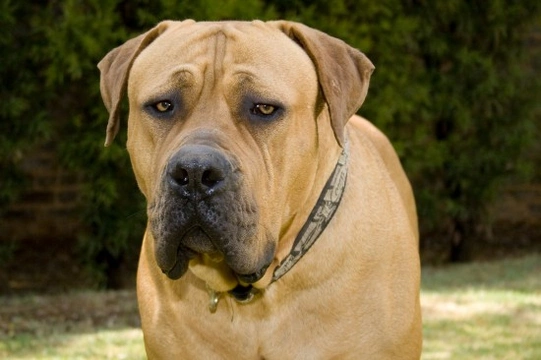
All about the South African Boerboel dog
The Boerboel dog is a large breed dog of the Mastiff type, hailing from South Africa, where it was originally bred to guard the land of rural farmers and homesteaders. South Africa is home to many large and fierce wild animals including hyenas, lions and other big game, and Boerboel dogs were traditionally kept as the first line of defence to protect property and families against these predators. They were also used to help to track game animals, and restrain larger, wounded prey animals while awaiting their handlers.
The history of the breed
The word “Boerboel” means “farmer’s dog” and the Boerboel breed is the only dog breed that was specifically created and bred within South Africa to assist farmers with livestock guarding and farm work. While the Boerboel dog has been a fixture within South Africa for centuries, there is still some dispute as to what original breeds were significant within the creation of the Boerboel dog itself. The chances are that the breed can trace its origins back to the cross-breeding of dogs imported by English, French and Dutch settlers, and native African dogs from the region.
Modern-day Boerboel dogs
With the growth of diamond mining in Africa during the 1920’s, the DeBeers diamond mining company imported large Mastiff dogs into South Africa and crossed them with the existing Boerboel dog breed as it stood at the time, in order to produce large, heavy dogs to guard the mines.
The Boerboel Breeders Association was established in 1983, with the intention of raising the profile of the breed both within South Africa and abroad, and promoting the Boerboel as a distinctive South African dog breed. Boerboel dogs remain popular within South Africa both as pets and as working dogs, and are exported internationally too.
The Boerboel is first and foremost a guarding dog, and they are renowned for their courage, tenacity and loyalty to their owners. However, these same traits mean that they can easily be trained to become fighting dogs, which has led to them being banned within Denmark.
Appearance
The Boerboel is a large dog with heavy musculature but a proportional appearance. They can weigh up to 80kg, and stand up to 70cm tall on average at the shoulder. The males of the breed are generally noticeably larger and heavier than the females.
They have a single-layered coat that is short and dense, and usually has a smooth, shiny appearance. The Boerboel can be seen in many colour variants, including fawn with a black muzzle, red, brown, and brindle. A black muzzle or some black facial markings are common but not compulsory in the breed.
Health
Due to its hybrid origins and regular outcrossings, the Boerboel dog breed benefits from the genetic diversity of hybrid vigour, and so is less prone to inherited genetic health problems than many other breeds that hail from small localised origins.
However, like most larger breeds of dog, the Boerboel does have slightly elevated risk factors for a range of health problems. Some of the more common issues include eye problems such as entropion or ectropion, and hip dysplasia and elbow dysplasia too. Female dogs of the breed may be more prone to vaginal hyperplasia, and juveniles of the breed have elevated risk factors for epilepsy, which is usually triggered by stress or dietary and metabolic changes.
When kept in their traditional working roles to guard farms, people and livestock, the Boerboel also runs the risk of becoming injured or even killed by altercations with predators, something that is of course not likely to be an issue with Boerboel dogs kept as pets.
The average lifespan for the Boerboel is generally thought to be around ten years old.
Temperament
The Boerboel might fairly be described as a challenging dog to keep, and one that may not be suitable for the first-time dog owner to tackle alone. They are highly intelligent and very capable of learning a wide range of commands and skills, but can also soon pick up bad habits or inadvertently learn things that you don’t want them to!
They can be prone to laziness, but will soon spring into action if their home or family is threatened, and are extremely loyal to their families, and very protective of their home territory. They are generally said to be good with children within the family, but may be wary of strangers if not properly introduced.
Boerboel dogs require quite a lot of time and commitment to be spent on their training, entertainment and exercise, and will soon become destructive and act up if bored. They require firm boundaries and consistent positive reinforcement training from an experienced handler who will gain the respect of the dog and be able to lead the dog from an alpha role. Due to their wariness of strangers, the Boerboel should be kept on a lead when outside of safely enclosed property, and may not thrive in a densely populated urban environment.



